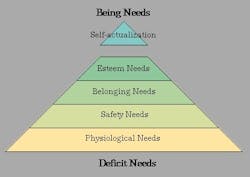By Paul Thomas, Managing EditorAccording to Maslows hierarchy of needs, human beings require safety and security before they can pursue their true potential. If youre just trying to hold down a job and keep a roof over your head, youre probably not seeking fulfillment in, say, ceramics lessons or a trek up Everest. First things first.
Savvy manufacturers know that workplace safety is the prerequisite for worker productivity and fulfillment, and theres a correlation between financial success and safety focus, illustrated by companies like Biogen Idec and Pfizer. As this months feature shows, manufacturers that put a premium on worker safety and ergonomics tend to be the most successful, period. But theres a big difference between implementing safety activities and checklists and establishing a zero-injury culture, says Don Groover, VP of Behavioral Science Technology, Inc. (Ojai, Calif.). As a leadership consultant, Groover has worked with plenty of pharmaceutical manufacturers. Many of them had safety program elements in place, yet their working environments were not safe.Enabling systems such as safety policies, meetings, and reward and recognition programs are but one of four elements that underpin a safe work environment, Groover believes. The others: leadership, culture, and sustaining factors such as selecting and promoting employees who adhere to safety standards.You can have a strong set of enabling systems, but if the pool of people who oversee and enact these programs is eroding, the enabling systems will grow weaker and weaker, Groover says.Groover preaches organizational safety, but hes really trying to develop leaders and strong corporate cultures. He and his colleagues at BST may work with an organization from a few months to a few years, starting at the CEO level but eventually working with front-line employees. On average, when BST works with all levels at a site, the organization sees a 55% reduction in medical treatment cases within the first year (to see a chart detailing recordable rates of injury, click the Download Now button below). Safety metrics are telling, but Groover knows his work is done when managers and supervisors understand how to implement a meaningful safety environment, and employees are engaged in the improvement process. True success comes when these lessons are applied and translated in quality activities other than safety.Safety is a vehicle for change, Groover says. Everyone benefits. Having that commonality allows us to align ourselves around one thing, and we find that were aligned around a lot of other things.Most pharmaceutical companies, being heavily regulated, have excellent workplace safety programs on paper. And yet theyre not all experiencing the same level of safe performance, Groover notices. Even within the same company or facility, one departments safety record can be stellar, anothers abysmal. Leadership is the key to breaking through the plateau and achieving a truly safe environment.Safety leaders come at all levels of an organization. Leaders at the VP level and above can most easily impact culture and sustaining systems, Groover says. Enabling systems are the purview of supervisors. The rigor and enthusiasm with which they engage employees is critical, he says. Plant-floor workers can lead by example, and also speak the language of safety among peers.Nevertheless, while every employee can and should be a safety leader, management can never abdicate its responsibility for safety, Groover says. If executives, managers and supervisors are not doing their jobs, workers cant fill the gaps.Moreover, workers will not want to. They are more apt to quit. As Maslow knew too well, safety comes first. For a white paper from BST on motivating safety leaders, click here.






